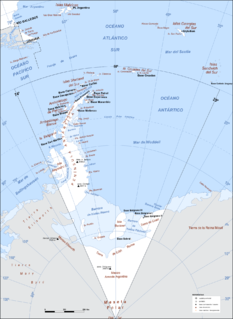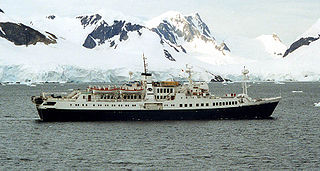
Hudson Strait links the Atlantic Ocean and Labrador Sea to Hudson Bay in Canada. This strait lies between Baffin Island and Nunavik, with its eastern entrance marked by Cape Chidley in Quebec and Resolution Island off Baffin Island. The strait is about 750 km long with an average width of 125 km, varying from 70 km at the eastern entrance to 240 km at Deception Bay.

The Arctic Archipelago, also known as the Canadian Arctic Archipelago, is a group of islands north of the Canadian mainland.

Argentine Antarctica is a sector of Antarctica claimed by Argentina as part of its national territory consisting of the Antarctic Peninsula and a triangular section extending to the South Pole, delimited by the 25° West and 74° West meridians and the 60° South parallel. This region overlaps with British and Chilean claims in Antarctica; however, all claims are suspended by the Antarctic Treaty System, of which Argentina is a founding signatory and permanent consulting member, with the Antarctic Treaty Secretariat being based in Buenos Aires.

Bangka Regency is a regency (kabupaten) of Bangka Belitung Islands, Indonesia. Sungailiat is its regency seat.

Sikorsky Glacier is a glacier on the west coast of Graham Land, Antarctica draining northwestwards into Hughes Bay both north and south of Sladun Peninsula, branching to enter Cierva Cove and Duarte Cove respectively.

Ice Gate Glacier is a narrow hanging glacier, tributary to Astudillo Glacier, between rock spurs on the west slope of Dallmeyer Peak, Danco Coast, Antarctica. It was named by the Polish Antarctic Expedition in about 1992, probably from the gatelike appearance of the spurs at the junction of the two glaciers.

Astudillo Glacier is a small glacier flowing into Paradise Harbor between Leith Cove and Skontorp Cove on the Danco Coast of Graham Land. The glacier was surveyed by the Chilean Antarctic Expedition of 1950–51, which applied the name, probably after an expedition member.

Alberts Glacier is a heavily crevassed glacier in Antarctica. It is about 8 miles (13 km) long, and flows east from Avery Plateau, Graham Land, until entering Mill Inlet between Balch Glacier and Southard Promontory. The glacier was photographed from the air by the U.S. Navy in 1968. It was delineated from these photographs by Directorate of Overseas Surveys, 1980, and positioned from surveys by Falkland Islands Dependencies Survey, 1947–57. In association with the names of Antarctic historians around the area, it was named by United Kingdom Antarctic Place-Names Committee after Fred G. Alberts, an American toponymist, and secretary of the Advisory Committee on Antarctic Names 1949–80.
Almirante Ice Fringe is a narrow ice piedmont bordering the southwest side of Andvord Bay on Danco Coast, Graham Land, Antarctica. Named by the Polish Antarctic Expedition, about 1995, after the Almirante Brown Antarctic Base on nearby Coughtrey Peninsula, Paradise Harbor.

Andrew Glacier is a glacier 3 nautical miles (6 km) long, flowing northeast into Ognen Cove in Charcot Bay immediately west of the Webster Peaks on Trinity Peninsula, northern Graham Land. It was charted in 1948 by the Falkland Islands Dependencies Survey (FIDS) who named the feature for Dr. James Darby Andrew, medical officer at the FIDS Hope Bay station in 1946–47.
Mount Banck is a conspicuous mountain of red rock, 675 m, dominating the small peninsula just west of Mascias Cove, on the west coast of Graham Land. In 1898 the Belgian Antarctic Expedition under Gerlache applied the name "Ile Banck" to a feature which was charted as an island separated from the mainland by a narrow channel. Air photos show it is actually a small peninsula, on which the most prominent feature is this mountain. The name Mount William, given by Biscoe in 1832 to a mountain which he described as being on the mainland but now identified on Anvers Island, has been used for the feature here described.
Cierva Cove is a cove lying 6 nautical miles (11 km) southeast of Cape Sterneck in Hughes Bay, just south of Chavdar Peninsula along the west coast of Graham Land, Antarctica. Shown on an Argentine government chart of 1950, it was named by the UK Antarctic Place-Names Committee in 1960 for Juan de la Cierva, the Spanish designer of the autogiro, which was the first successful rotating wing aircraft in 1923.
Clifford Peak is a peak, 1,160 metres (3,800 ft) high, at the northeast end of the Osterrieth Range, Anvers Island, in the Palmer Archipelago. It was probably first seen by the Belgian Antarctic Expedition, 1897–99, under Gerlache. The peak was named by members of HMS Snipe following an Antarctic cruise in January 1948, for Sir G. Miles Clifford.

Mount Wild is a sharply defined rock ridge with several summits, the highest 945 m, standing at the north side of the entrance to Sjögren Inlet on the east coast of Trinity Peninsula in Graham Land, Antarctica. First charted by the Falkland Islands Dependencies Survey (FIDS) in 1945 and named for Frank Wild.

Tu Rocks is a two low rocks lying in Maxwell Bay 2 nautical miles (3.7 km) east of the southwest end of King George Island, in the South Shetland Islands. The name appears to have been given by DI personnel on the Discovery II who charted the rocks in 1935. Tu is apparently phonetic for two.
False Island is the largest of three islands lying at the east side of Hackapike Bay, off the northeast coast of Anvers Island, in the Palmer Archipelago. Two islands were charted in this approximate position by the French Antarctic Expedition, 1903–05, under Jean-Baptiste Charcot. False Island was named by Discovery Investigations personnel on the Discovery in 1927.
Pear Island is a small island lying immediately southwest of False Island, off the northeast coast of Anvers Island in the Palmer Archipelago. The existence of the island is noted on a British hydrographic chart of 1929; the name is presumably descriptive of shape and appears on a British hydrographic chart of 1952.
Mouillard Glacier is a glacier flowing into the southeast corner of Brialmont Cove, on the west coast of Graham Land, Antarctica. It was photographed by the Falkland Islands and Dependencies Aerial Survey Expedition in 1956–57, and mapped from these photos by the Falkland Islands Dependencies Survey. The glacier was named by the UK Antarctic Place-Names Committee in 1960 for Louis P. Mouillard, a French pioneer of gliding flight.

Sphinx Island is an island 2 nautical miles (3.7 km) long and 1 nautical mile (1.9 km) wide, having a bare rocky summit with vertical faces on all four sides, lying in the entrance to Barilari Bay north of Loqui Point on Velingrad Peninsula, Graham Land in Antarctica. Discovered and named by the British Graham Land Expedition (BGLE), 1934–37, under Rymill.













